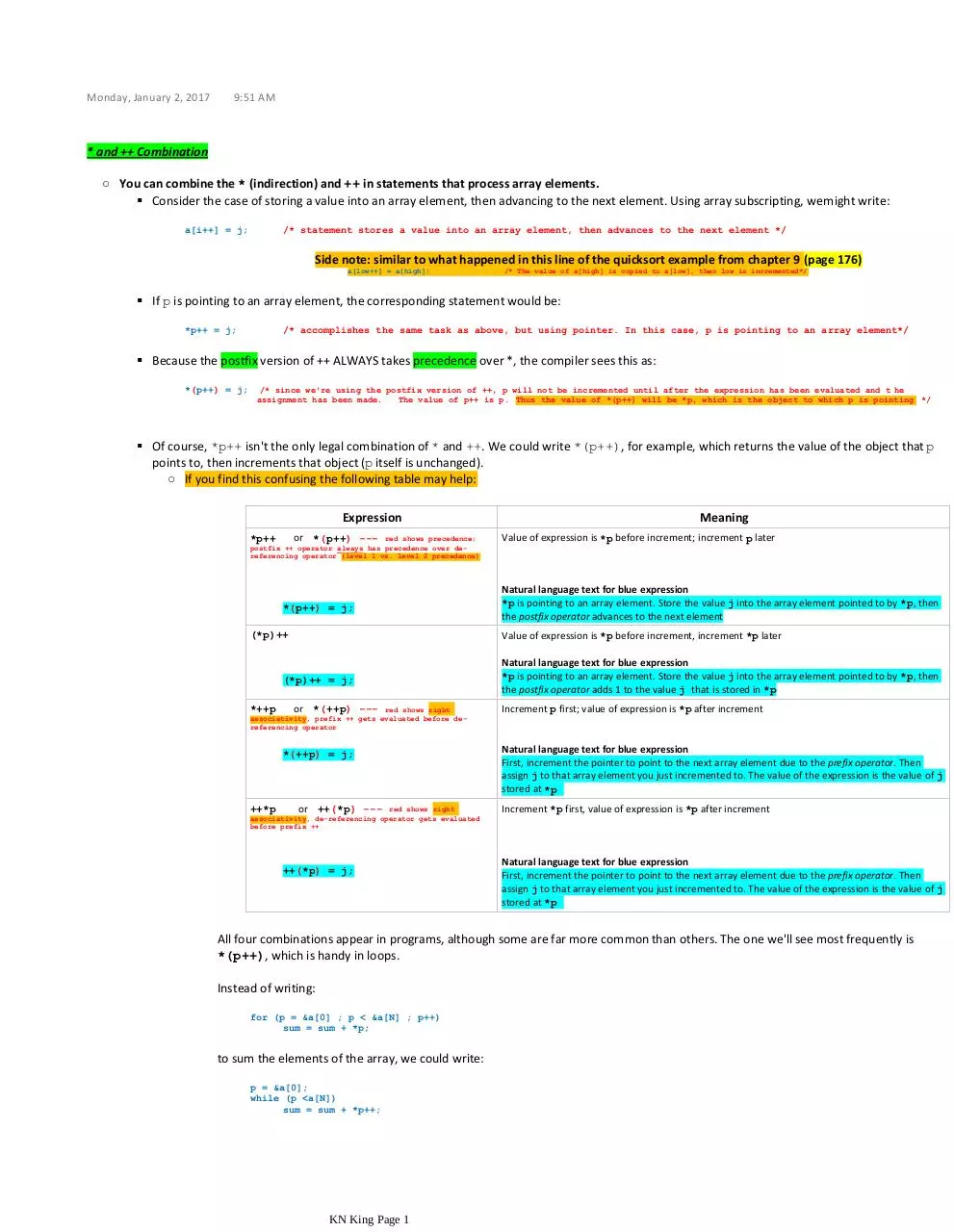and ++ Combination (PDF)
File information
This PDF 1.5 document has been generated by Microsoft® OneNote® 2016, and has been sent on pdf-archive.com on 02/01/2017 at 15:58, from IP address 96.255.x.x.
The current document download page has been viewed 381 times.
File size: 684.47 KB (1 page).
Privacy: public file

File preview
Monday, January 2, 2017
9:51 AM
* and ++ Combination
○ You can combine the * (indirection) and ++ in statements that process array elements.
Consider the case of storing a value into an array element, then advancing to the next element. Using array subscripting, we might write:
a[i++] = j;
/* statement stores a value into an array element, then advances to the next element */
Side note: similar to what happened in this line of the quicksort example from chapter 9 (page 176)
a[low++] = a[high];
/* The value of a[high] is copied to a[low], then low is incremented*/
If p is pointing to an array element, the corresponding statement would be:
*p++ = j;
/* accomplishes the same task as above, but using pointer. In this case, p is pointing to an array element*/
Because the postfix version of ++ ALWAYS takes precedence over *, the compiler sees this as:
*(p++) = j;
/* since we're using the postfix version of ++, p will not be incremented until after the expression has been evaluated and t he
assignment has been made.
The value of p++ is p. Thus the value of *(p++) will be *p, which is the object to which p is pointing */
Of course, *p++ isn't the only legal combination of * and ++. We could write *(p++), for example, which returns the value of the object that p
points to, then increments that object (p itself is unchanged).
○ If you find this confusing the following table may help:
Expression
or *(p++) ---
red shows precedence;
*p++
postfix ++ operator always has precedence over dereferencing operator (level 1 vs. level 2 precedence)
*(p++) = j;
(*p)++
Meaning
Value of expression is *p before increment; increment p later
Natural language text for blue expression
*p is pointing to an array element. Store the value j into the array element pointed to by *p, then
the postfix operator advances to the next element
Value of expression is *p before increment, increment *p later
(*p)++ = j;
*++p
or *(++p) --- red shows right
associativity, prefix ++ gets evaluated before dereferencing operator
*(++p) = j;
++*p
or ++(*p) --- red shows right
associativity, de-referencing operator gets evaluated
before prefix ++
++(*p) = j;
Natural language text for blue expression
*p is pointing to an array element. Store the value j into the array element pointed to by *p, then
the postfix operator adds 1 to the value j that is stored in *p
Increment p first; value of expression is *p after increment
Natural language text for blue expression
First, increment the pointer to point to the next array element due to the prefix operator. Then
assign j to that array element you just incremented to. The value of the expression is the value of j
stored at *p
Increment *p first, value of expression is *p after increment
Natural language text for blue expression
First, increment the pointer to point to the next array element due to the prefix operator. Then
assign j to that array element you just incremented to. The value of the expression is the value of j
stored at *p
All four combinations appear in programs, although some are far more common than others. The one we'll see most frequently is
*(p++), which is handy in loops.
Instead of writing:
for (p = &a[0] ; p < &a[N] ; p++)
sum = sum + *p;
to sum the elements of the array, we could write:
p = &a[0];
while (p <a[N])
sum = sum + *p++;
KN King Page 1
Download and ++ Combination
and ++ Combination.pdf (PDF, 684.47 KB)
Download PDF
Share this file on social networks
Link to this page
Permanent link
Use the permanent link to the download page to share your document on Facebook, Twitter, LinkedIn, or directly with a contact by e-Mail, Messenger, Whatsapp, Line..
Short link
Use the short link to share your document on Twitter or by text message (SMS)
HTML Code
Copy the following HTML code to share your document on a Website or Blog
QR Code to this page

This file has been shared publicly by a user of PDF Archive.
Document ID: 0000530819.